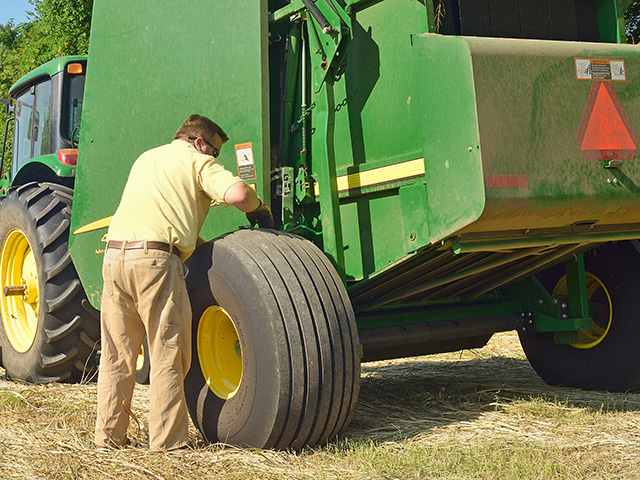Dry Conditions Raise Baler Fire Risk
Preventative Maintenance Lowers Baler Fire Danger During Drought
OMAHA (DTN) -- Baling hay, in general, creates the risk of a fire with dry plant material going through a machine with many moving parts, which can spark a fire. Much of the Northern Plains is in the midst of a historic drought, which only adds to the risk of baler fires.
Preventive measures, such as basic maintenance and keeping the baler clean from dust and plant material, can go a long way to ensure that hay baling is both productive and safe.
DROUGHT IS DANGEROUS
The severe drought gripping the Northern Plains is creating a situation where more baler fires could occur. (See https://www.ag.ndsu.edu/….) Combine hot and dry conditions with poor maintenance that causes friction and static to build while baling, and this situation could lead to devastating results.
Also, producers may have driven a long distance from the farm to the field and then parked their truck in the field, according to Kindred (North Dakota) Fire and Rescue Chief Rick Schock. Heat from the pickup's exhaust can start a dry field of plant material on fire as well.
"It just creates the receipt for disaster," Schock said.
Angie Johnson, North Dakota State University (NDSU) Extension educator for Steele County as well as NDSU's farm and ranch safety coordinator, said in the news release that the most common reason for a baler fire is mechanical issues, primarily problems with bearings within the baler. The first step to prevent fires is to walk around the baler to conduct a visual assessment.
"Also, during your visual assessment, if you see purple discoloration of the rollers on your round balers, this can be a sign of a 'hot spot' on the baler," Johnson said. "These 'hot spots' are indicators that the bearing might be wearing out and needs to be replaced."
Johnson said operators need to examine belts closely and check for belts that may have become loose around the rollers. If a belt is too loose, it starts slipping on the roller, which causes friction.
P[L1] D[0x0] M[300x250] OOP[F] ADUNIT[] T[]
This can allow dust particles, loose material and the bale inside the bale chamber to ignite, she warned.
KEEP BALERS CLEAN
In a post titled "Preventing an Unwanted Baler Fire," South Dakota State University (SDSU) Extension Dairy Field Specialist Tracey Erickson wrote there is a checklist baler operators should follow to prevent fires. (See https://extension.sdstate.edu/….)
The first thing on the list is to remove any trash or plant material accumulation on the baler and take time to blow off dust, leaves and dry stems. Keep the baler free and clean of grease, oil and hydraulic fluid accumulation, which also attracts and holds dust while baling and is highly ignitable.
Erickson suggested farmers carry a fire extinguisher on the baler or tractor at all times and make sure it is still adequately charged and is not beyond its expiration date. Operators should also carry 4 to 5 gallons of water and a shovel or spade to throw dirt on a fire.
Baler operators should not overfill the fuel tank, as the overflow of fuel can potentially ignite. Immediately repair any hydraulic or fuel leaks and clean up any spills.
Hydraulic fluid is flammable, she wrote.
Other recommendations include to not smoke near the baler or tractor, carry a charged cellphone at all times, and be able to give directions to your location in an emergency situation.
"Lastly, make sure that you communicate with others where you will be working so that they also will know where to locate you if an emergency situation would arise," Erickson wrote. (See a blog about creating a safety checklist before working alone at https://www.dtnpf.com/….)
"Prevention and maintenance only take a few minutes versus trying to recover from a catastrophic loss caused by a potentially avoidable fire."
DAILY MAINTENANCE IMPORTANT
Daily maintenance during the hay season will pay off for hay producers, according to hay equipment manufacturer Vermeer. (See https://makinhay.com/….) The correct maintenance will allow you to achieve better performance, reduce wear, have less downtime, lengthen baler life and, potentially, increase resale value.
Vermeer breaks up daily maintenance into two categories: a daily start checklist and a daily finish checklist.
The start list includes to check all safety items before baling. This includes all fire extinguishers, highway lights, guards and safety signs.
Other daily start items are to adjust the bale density setting, check and adjust all drive chains, repair hydraulic leaks and test all hydraulic functions. Also, keep an eye out for missing pickup teeth, check twine tension and/or netwrap system, inspect tire pressure/condition and check hitch connection.
The daily finish checklist includes items such as to clean the baler with a leaf blower or compressed air, grease per lubrication chart, check all components (belts, bearings and lacings), check lacing pins and tighten or replace loose or missing hardware.
(To learn more about Vermeer hay baling practices, visit https://makinhay.com/….)
Russ Quinn can be reached at russ.quinn@dtn.com
Follow him on Twitter @RussQuinnDTN
(c) Copyright 2021 DTN, LLC. All rights reserved.




